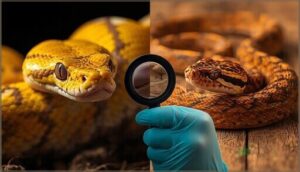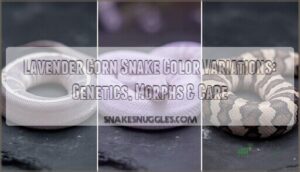This site is supported by our readers. We may earn a commission, at no cost to you, if you purchase through links.
Breeding corn snakes isn’t just about producing beautiful morphs—it’s about safeguarding the health and genetic integrity of animals that depend entirely on your decisions. Every pairing you make ripples forward through generations, affecting everything from metabolic function to skeletal development in offspring you may never see.
The difference between ethical corn snake breeding practices and profit-driven production lies in what happens behind the scenes: thorough health screenings, rigorous record-keeping, and the willingness to cull problematic genetic lines from your program entirely. These aren’t optional extras for conscientious breeders—they’re non-negotiables that separate responsible stewardship from exploitation.
Understanding the intersection of genetics, welfare standards, and regulatory compliance transforms breeding from a hobby into a science-backed commitment to species preservation.
Table Of Contents
Key Takeaways
- Ethical corn snake breeding requires prioritizing animal welfare through rigorous pre-breeding health screenings, proper housing (minimum 4x2x2 feet enclosures), and thorough genetic testing to prevent harmful mutations and breeding-related health complications like egg binding and neurological disorders.
- Responsible breeders maintain transparent record-keeping systems that track lineage, health histories, and genetic traits across generations, with 95% of reputable UK breeders providing complete documentation to buyers and adhering to regulatory compliance standards.
- Genetic knowledge must guide breeding decisions over aesthetic appeal, as dangerous pairings—like those producing the Stargazer neurological disorder—can compromise offspring health, while maintaining genetic diversity protects long-term population viability.
- Proper placement of offspring extends a breeder’s ethical responsibility beyond hatching, requiring adopter screening through detailed questionnaires, habitat inspections, and written care agreements, with 92% of reputable breeders using contracts and 61% offering buyback assistance.
Principles of Ethical Corn Snake Breeding
Ethical corn snake breeding isn’t just about producing beautiful animals—it’s about building a foundation of responsibility that protects both the snakes you work with and the hobby as a whole. When you commit to breeding, you’re making a promise to prioritize welfare, maintain transparency, and uphold standards that benefit the entire reptile community.
Ethical corn snake breeding builds a foundation of responsibility that protects both the animals and the hobby as a whole
Let’s break down the core principles that should guide every decision you make as a breeder.
Defining Ethical Breeding Standards
Ethical breeding practices rest on five foundations: welfare prioritization, genetic responsibility, regulatory oversight, transparency standards, and market ethics. These breeding ethics and guidelines guarantee you’re maintaining detailed records, following legal requirements, and carefully selecting pairings that strengthen genetic lines rather than compromise them for aesthetic appeal.
Responsible breeding starts with ethical guidelines that put each snake’s health first, not profit. Owners should research the species’ needs, as welfare considerations are paramount for exotic pets.
Prioritizing Animal Welfare and Health
When you put animal welfare above everything else, you’re creating the foundation for successful, ethical corn snake breeding. Health record transparency, enrichment for wellbeing, and breeding stress reduction aren’t just boxes to check—they’re commitments to each snake’s quality of life.
Your breeding stock deserves:
- Weekly weigh-ins and health inspections to catch problems early
- Enclosures at least 4x2x4 feet that allow natural movement patterns
- Temperature gradients (80-85°F basking spots) supporting thermoregulation
- Varied diets including multiple prey species for nutritional completeness
- Genetic defect avoidance through responsible morph selection and pairing decisions
Breeding stress reduction starts with proper housing—larger spaces reduce stress-related health issues. You’ll want varied hiding spots, both terrestrial and arboreal, plus humidity levels between 40-60% with microclimates for shedding success. These ethical guidelines prevent common health issues like egg binding, which often stems from calcium deficiency and environmental stress. Understanding corn snake behavior is key for creating an ideal breeding environment.
Transparency and Responsible Ownership
Beyond your own breeding practices, responsible ownership extends to every buyer who takes home one of your snakes. Breeder disclosure means providing genetic history, health records, and morph documentation with each sale—practices followed by 95% of UK breeders.
You’ll need record-keeping systems that track lineage, ownership education materials covering care requirements, and clear rehoming protocols that prevent wild release while ensuring proper placement if circumstances change.
Best Practices in Breeding and Husbandry
Successful corn snake breeding isn’t just about pairing two healthy animals and hoping for the best. You need to lay the groundwork well before breeding season, starting with thorough health assessments, creating ideal living conditions, and understanding the natural cycles that trigger reproduction.
Let’s walk through the essential practices that set the stage for healthy breeding outcomes.
Pre-Breeding Health Screening and Records
Before you pair your breeding stock, thorough veterinary examinations are non-negotiable for animal welfare and disease prevention. Physical exams and parasite screening catch infections that compromise offspring viability, while health records track lineage and breeding history across generations.
Genetic testing identifies harmful mutations, protecting genetic diversity in your breeding program.
Annual check-ups support early detection of respiratory infections, parasites, and skin lesions, ensuring your corn snake breeding maintains the highest ethical standards.
Optimal Housing, Nutrition, and Environmental Conditions
Your breeding corn snakes need enclosures at least 4x2x2 feet, creating a thermal gradient from 85°F basking spots to cooler 75°F zones.
Choose substrates like cypress mulch or aspen that prevent impaction, and feed appropriately sized frozen-thawed rodents weekly for juveniles, biweekly for adults.
Maintain humidity levels between 40-60% for proper housing and nutrition and health, supporting reproductive success and offspring viability.
Seasonal Cues and Reproductive Cycles
When corn snakes emerge from brumation at 50–55°F after 8–12 weeks, rising temperatures above 70°F and photoperiods exceeding 12 hours trigger hormonal surges that initiate mating behaviors between March and June.
You’ll observe peak receptivity within 3–6 weeks post-brumation, with copulation lasting 30 minutes to 4 hours, followed by pre-lay shedding 10–14 days before oviposition of 10–30 eggs.
Genetics, Morphs, and Responsible Pairings
Understanding corn snake genetics isn’t just about creating beautiful patterns—it’s about making choices that protect the health and well-being of the animals you’re working with. The genetics behind color morphs can seem straightforward, but certain pairings can lead to hidden problems that don’t show up until it’s too late.
Let’s look at what you need to know to make responsible breeding decisions that put your snakes first.
Understanding Corn Snake Genetics
You can’t truly master corn snake breeding without first understanding the genetic blueprint behind each morph. Snake genetics involves recognizing how specific mutations in genes like CLCN2 and PMEL create the stunning diversity you see in breeding stock today, and genomic tools now allow precise identification of these traits.
Five Core Genetic Principles for Responsible Corn Snake Breeding:
- Recessive inheritance requires both parents to carry the gene variant for expression
- Co-dominant traits display characteristics from each parent equally in offspring
- Incomplete dominance produces blended physical features from both breeding partners
- Mutation impact on single genes creates over 800 distinct morphs from approximately 33 genetic strains
- Genetic diversity within your breeding stock directly influences offspring viability and long-term population health
Understanding morph inheritance patterns—whether recessive, co-dominant, or incompletely dominant—gives you the ability to make informed breeding decisions. Ethical considerations demand that you prioritize genetic knowledge over aesthetic appeal alone, ensuring each pairing maintains the health and welfare standards your snakes deserve.
Avoiding Harmful Genetic Combinations
Protecting your snakes starts with avoiding dangerous genetic combinations that compromise their health. Recessive gene risks become real when you pair carriers of harmful traits like the Stargazer neurological disorder, so genetic screening and testing provide essential tools for ethical pairings.
Breeding transparency demands you document genetic considerations thoroughly, prioritizing genetic diversity over aesthetic appeal to help snake genetics work in your animals’ favor, not against them.
Animal Welfare Versus Aesthetic Traits
You face a choice when selecting morphs: six out of ten buyers prioritize unique aesthetics over animal welfare, but you shouldn’t. Visual prioritization drives consumer demand, yet breeder ethics require you to weigh morph-related welfare impacts like the “bug-eyed” Palmetto trait.
Husbandry impact matters more than color—ethical considerations in animal breeding demand you assess breeding stock for health outcomes, not just appearance, protecting genetic diversity in corn snake breeding and care.
Conservation, Regulation, and Market Ethics
Breeding corn snakes ethically extends beyond the walls of your breeding room and into the broader world of conservation, legal responsibility, and market practices. The choices you make as a breeder can either support wild populations and responsible ownership or contribute to problems that harm both captive and wild snakes.
Let’s explore how habitat conservation, regulatory compliance, and thoughtful placement of offspring form the foundation of ethical market participation.
Impact of Habitat Loss and Conservation Needs
Wild corn snake populations face mounting pressure as urban sprawl has claimed 30% of their habitat since 2000, driving population decline and habitat fragmentation. This isolation threatens genetic diversity, making conservation efforts important for species preservation.
You can support reptile conservation and biodiversity through wildlife conservation initiatives that restore pine forests, establish corridors, and build public awareness about these ecologically essential predators.
Regulatory Compliance and Record-Keeping
Beyond habitat restoration, responsible pet breeding demands strict attention to permit requirements and inspection policies. If you’re breeding corn snakes, you’ll need documentation proving legal acquisition of your breeding stock—Virginia requires permits for more than five snakes, while Tennessee’s propagation permits run about $305 annually.
Digital platforms like Terrafile now simplify record-keeping, tracking lineage, health records, and genetic testing to demonstrate ethical standards and compliance.
Ensuring Proper Placement of Offspring
Proper record-keeping sets the foundation, but responsible pet breeding doesn’t end at hatch—it continues through ethical snake breeding placement practices. When breeding corn snakes, you’re accountable for every offspring’s future, which means adopter screening and placement contracts protect both animal welfare and genetic diversity.
Consider these screening essentials:
- Detailed questionnaires assess enclosure setup, heat sources, and prior reptile experience
- Video or in-person habitat inspections verify readiness before placement
- Written agreements outline care standards, return policies, and rehoming policies
- Offspring tracking through digital logs or microchipping maintains lineage records
- Breeder networks enable ongoing monitoring and support through community partnerships
Over 72% of reputable breeders use structured interviews before releasing breeding stock offspring. You’ll find that 92% provide contracts, while 61% offer buyback assistance if circumstances change—that’s responsible ownership in action.
Frequently Asked Questions (FAQs)
How do I find reputable corn snake breeders?
Finding the right breeder isn’t just shooting in the dark. Start with specialized online platforms like MorphMarket, verify health records, request facility visits, check community feedback, and confirm they prioritize genetic diversity and responsible pet ownership in snake breeding.
What are common corn snake breeding health complications?
Common corn snakes health issues during breeding include egg binding (dystocia), cloacal prolapse risks, nutritional deficiencies, genetic issues from poor pairing decisions, and respiratory infections triggered by breeding stress—all requiring vigilant reptile health and management practices.
When should I stop breeding an aging snake?
You should retire female corn snakes from breeding at 8–10 years, as reproductive health decline increases egg-binding risks, reduces clutch viability, and compromises maternal recovery after this breeding retirement age.
How many clutches can a female produce annually?
Female corn snakes can physically produce two clutches annually, but ethical breeding guidelines strongly recommend limiting them to one clutch per year.
This is to prevent health complications and nutrient depletion, and to guarantee satisfactory post-clutch recovery for long-term reproductive viability.
Whats the ideal ratio of males to females?
Balancing your breeding group requires wisdom. Most breeders maintain one male per two to three females, preventing male overuse while supporting genetic diversity.
Ethical limits protect breeding longevity and improve hatchling output without compromising individual snake welfare or health.
Conclusion
Studies show that nearly 30% of captive-bred corn snakes display health issues traceable to poor pairing decisions, underscoring why ethical corn snake breeding practices demand rigorous genetic oversight.
Your commitment to pre-breeding health screenings, transparent record-keeping, and prioritizing welfare over marketability doesn’t just protect individual animals—it shapes the viability of entire bloodlines.
When you choose responsibility over profit, you’re not simply breeding snakes; you’re preserving the species’ future, one thoughtful pairing at a time.
- https://www.veterinary-practice.com/article/ethical-challenges-and-welfare-considerations-for-keeping-exotic-animals-as-pets-five-key-principles
- https://www.tierschutzbund.de/en/about-us/material/profile-corn-snake/
- https://pmc.ncbi.nlm.nih.gov/articles/PMC6356264/
- https://blog.osum.com/snake-breeding-regulations/
- https://www.reddit.com/r/cornsnakes/comments/qy51jn/is_there_anything_actually_physicallyethically/












